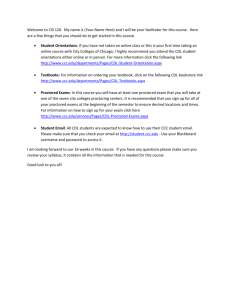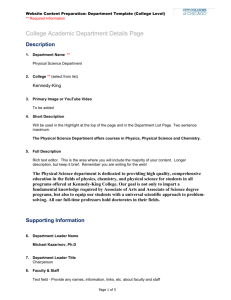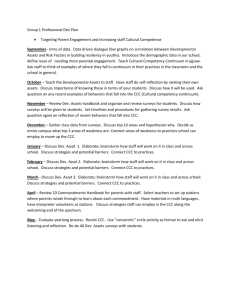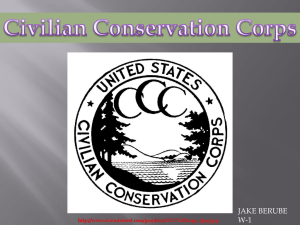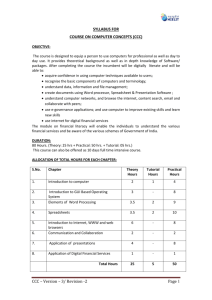CCC- Collaborative Clued Corrections
advertisement
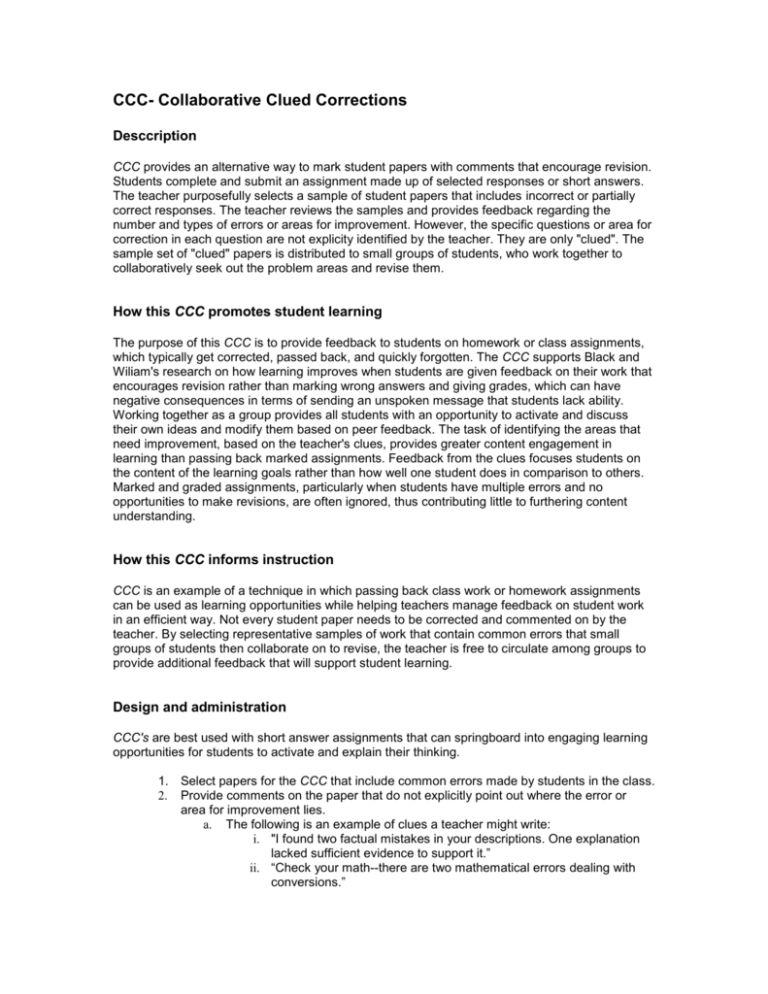
CCC- Collaborative Clued Corrections Desccription CCC provides an alternative way to mark student papers with comments that encourage revision. Students complete and submit an assignment made up of selected responses or short answers. The teacher purposefully selects a sample of student papers that includes incorrect or partially correct responses. The teacher reviews the samples and provides feedback regarding the number and types of errors or areas for improvement. However, the specific questions or area for correction in each question are not explicity identified by the teacher. They are only "clued". The sample set of "clued" papers is distributed to small groups of students, who work together to collaboratively seek out the problem areas and revise them. How this CCC promotes student learning The purpose of this CCC is to provide feedback to students on homework or class assignments, which typically get corrected, passed back, and quickly forgotten. The CCC supports Black and Wiliam's research on how learning improves when students are given feedback on their work that encourages revision rather than marking wrong answers and giving grades, which can have negative consequences in terms of sending an unspoken message that students lack ability. Working together as a group provides all students with an opportunity to activate and discuss their own ideas and modify them based on peer feedback. The task of identifying the areas that need improvement, based on the teacher's clues, provides greater content engagement in learning than passing back marked assignments. Feedback from the clues focuses students on the content of the learning goals rather than how well one student does in comparison to others. Marked and graded assignments, particularly when students have multiple errors and no opportunities to make revisions, are often ignored, thus contributing little to furthering content understanding. How this CCC informs instruction CCC is an example of a technique in which passing back class work or homework assignments can be used as learning opportunities while helping teachers manage feedback on student work in an efficient way. Not every student paper needs to be corrected and commented on by the teacher. By selecting representative samples of work that contain common errors that small groups of students then collaborate on to revise, the teacher is free to circulate among groups to provide additional feedback that will support student learning. Design and administration CCC's are best used with short answer assignments that can springboard into engaging learning opportunities for students to activate and explain their thinking. 1. Select papers for the CCC that include common errors made by students in the class. 2. Provide comments on the paper that do not explicitly point out where the error or area for improvement lies. a. The following is an example of clues a teacher might write: i. "I found two factual mistakes in your descriptions. One explanation lacked sufficient evidence to support it.” ii. “Check your math--there are two mathematical errors dealing with conversions.” iii. “There is one scientific term you used in a way that might be interpreted incorrectly.” iv. “One of your explanations could be improved by using a drawing to explain your solution to the problem.” 3. Feedback/revision groups should be formed based on the learning needs and social interaction of the individuals in the group. a. Each small group can include the student whose paper was marked with clues. 4. Students work together in their small groups to identify the areas of correction or improvement, discuss their ideas related to the questions on the assignment, and collaboratively revise the work once all members of the group accept the corrections. 5. The work is resubmitted and then becomes representative of the group, rather than the individual. a. This encourages others to participate even though the student work is not their own. 6. After resubmitting the group's work, the teacher returns the remaining unmarked papers for students to revise on their own or with a partner. a. Students become more interested in reviewing their own unmarked papers and looking for areas to change or improve on, after having an opportunity to first analyze another student's work. It is important to provide time to teach this strategy and allow students an opportunity to practice it. One way of doing this is to choose one or two samples of anonymous student work to copy, write clues, and use with the whole class in examining the clues, looking for the areas that need revision, and discussing and making revisions to improve the quality and content accuracy of the work. Modifications Use short answer, matching, fill in the blank, or multiple choice with students who have a difficult time deciphering handwriting or reading a lot of student handwritten text. Note the number of answers that need revision. Even though questions and responses are not as robust in a forcedchoice assignment as they are in an open-response format, the discussions that ensue during the CCC provide an opportunity for rich content-focused dialogue. Caveats Be careful that students do not construe this as an opportunity to put less effort into their own work if they know that only a few papers will be selected for revision. CCC works best in classroom environments where students embrace the idea that their own work is an important means of helping all students improve the quality of their work. Make sure that all students have an opportunity to review their own work after the CCC, regardless of whether their papers were the ones selected to be clued.


